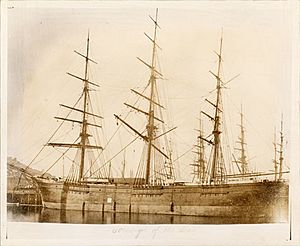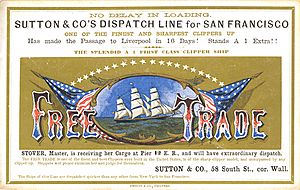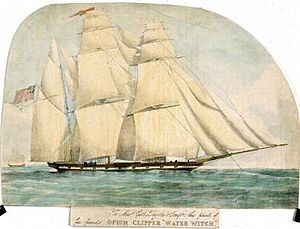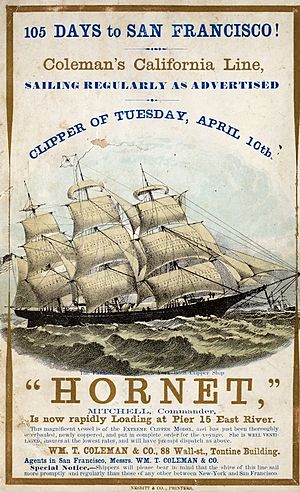Clipper facts for kids
A clipper was a super-fast sailing ship from the 19th century. The name "clipper" comes from an old word meaning "fast." Clippers had several tall masts and a special type of sail setup called a square rig. They were also quite narrow compared to how long they were.
Most clipper ships were built in British and American shipyards. However, countries like France and the Netherlands also built some. Clippers sailed all over the world! They were especially busy on trade routes between the United Kingdom and its colonies in the east. They also sailed across the Atlantic Ocean and on the famous route from New York to San Francisco around Cape Horn during the California Gold Rush. Dutch clippers, built from the 1850s, were used to bring tea to Europe and carry passengers to and from Java.
Contents
What Does "Clipper" Mean?
The word "clipper" probably comes from the verb "clip." Long ago, "clip" could mean to run or fly very quickly. For example, in the 1600s, an English poet named John Dryden used "clip" to describe a falcon's fast flight. He said the falcon "clips it down the wind."
These ships seemed to "clip along" the ocean water, meaning they moved very fast. So, "clip" became a word for speed. People also used it for fast horses and other speedy things. Even today, we sometimes say "going at a good clip" to mean moving quickly!
It's not totally clear when the word "clipper" was first used for ships. But it seems to have started in America with the Baltimore clippers in the late 1700s. These new ships were designed to "clip" over the waves instead of plowing through them. Because of their amazing speed, they became known as "clippers."
Clipper vs. Windjammer
A clipper is often confused with a windjammer, but they are very different types of ships!
- Clippers were built only for speed. They carried small amounts of very valuable cargo, like tea, spices, or special goods. Clippers usually had short lives, often being taken apart after only 20 years.
- Windjammers were large sailing ships built to carry a lot of cargo. They were easy to handle and carried cheaper, bulky goods like grain or wood. Windjammers could last for 50 years or more! Some windjammers are even still used today as school ships.
History of Clippers

The first ships called "clippers" were the Baltimore clippers. These were a type of topsail schooner developed in the Chesapeake Bay area before the American Revolution. They were most popular between 1795 and 1815.
The Flying Cloud was a famous clipper ship. It set a world record for the fastest trip between New York and San Francisco, completing it in just 89 days and 8 hours! This record stood for over 100 years, from 1854 until 1989.
China Clippers
Some of the most famous clippers were the China clippers. These were also called Tea clippers or Opium clippers. They were designed to sail on trade routes between Europe and the East Indies.
One of the last remaining examples of these ships is the Cutty Sark. It is kept in a special dry dock in Greenwich, United Kingdom. The ship was damaged by fire in 2007 while being repaired. As part of its long-term care, the ship was permanently lifted three meters above the dry dock floor in 2010.
Clippers were built for trades that needed speed, like carrying tea. Getting tea to market early meant it was worth more money. These fast ships were perfect for carrying small amounts of high-value goods, such as tea, spices, people, and mail. There was a lot of public competition among the clippers, and their travel times were even printed in newspapers! Clippers usually had short working lives and were often taken apart for parts after about 20 years.
Why Clippers Declined
The use of clipper ships started to slow down after an economic downturn in 1857. The main reason for their decline was the rise of the steamship. Steamships could travel without relying on wind, making them more reliable and eventually faster for long journeys.
Clipper Ship Sailing Cards
Clipper ship departures, especially from New York and Boston to San Francisco, were advertised using special cards. These "sailing cards" were a bit bigger than today's postcards. They were made using printing presses and wood engravings on thick paper.
Most clipper cards were printed in the 1850s and 1860s. They were some of the first colorful advertisements in America. Not many of these cards (maybe 3,500) still exist today. Because they look amazing, are rare, and are important pieces of sailing and printing history, collectors and museums really value them.
Images for kids
-
Cutty Sark, a noted British clipper.
See also
 In Spanish: Clíper para niños
In Spanish: Clíper para niños











